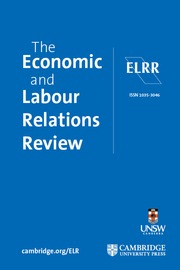Introduction
Disability employment
The social model of disability posits that barriers faced by people with disabilities are imposed by society (Oliver Reference Oliver2013) and contrasts to the medical model of disability that focuses on individuals and their impairments. Whilst there are different versions of the social model, the theme of disabling barriers imposed by society is a core consistency. According to the social model, one driver of the disability employment gap is employer attitudes towards people with disabilities (Antonopoulos et al Reference Antonopoulos, Sugden and Saliba2023; Derbyshire et al Reference Derbyshire, Spencer, Grosskopf and Blackmore2023; L’Horty et al Reference L’Horty, Mahmoudi, Petit and Wolff2022), with persistent myths around lower productivity and increased sickness absence (Bonaccio et al Reference Bonaccio, Connelly, Gellatly, Jetha and Martin Ginis2020). There is also evidence that negative attitudes towards disability persist in both large and small firms (Bjørnshagen Reference Bjørnshagen2022; Derbyshire et al Reference Derbyshire, Spencer, Grosskopf and Blackmore2023). Further, the world of work was traditionally (i.e. pre-COVID-19) structured with barriers to meaningful and sustained employment opportunities for people with disabilities. Employers can be inflexible when it comes to changes to these traditional working practices (Molyneux Reference Molyneux2023). Removing these barriers has the potential to increase the accessibility of employment opportunities for people with disabilities. This includes people with disabilities being disproportionately likely to be involved in precarious work arrangements (Ruppel Reference Ruppel2023; Shuey and Jovic Reference Shuey and Jovic2013).
In contrast, there is increasing evidence that ‘Good Work’ (Taylor et al Reference Taylor, Marsh, Nicol and Broadbent2017) can bring health and well-being benefits. It is also worth noting the positive impacts of employment on physical (Hergenrather et al Reference Hergenrather, Zeglin, McGuire-Kuletz and Rhodes2015a; van der Noordt et al Reference van der Noordt, IJzelenberg, Droomers and Proper2014) and mental health (Hergenrather et al Reference Hergenrather, Zeglin, McGuire-Kuletz and Rhodes2015b) and the negative impacts of unemployment on physical (Norström et al Reference Norström, Virtanen, Hammarström, Gustafsson and Janlert2014) and mental health (Modini et al Reference Modini, Joyce, Mykletun, Christensen, Bryant, Mitchell and Harvey2016). However, more people with disabilities are unemployed compared to people without disabilities; 7.3% in the fourth quarter of 2022 compared with just 3.2% (Office for National Statistics 2023a). The pandemic has also had a disproportionate negative impact on people with disabilities (Brown and Ciciurkaite Reference Brown and Ciciurkaite2023; Jones Reference Jones2022). This means that people with disabilities are twice as likely to be unemployed compared to people without disabilities. 17.7% (9.8 million people) of the population of England have a disability (Office for National Statistics 2023b), corresponding to 18.7% of females and 16.5% of males (Office for National Statistics 2023c). Similarly, the employment rate in the UK, which takes into account people not actively seeking work, was 53.2% for people with disabilities in the fourth quarter of 2022, compared with 82.8% for people without disabilities. This gap of 29.6% is referred to as the disability employment gap. The UK is not alone in experiencing a disability employment gap with other studies reporting a disability employment gap as a common feature of labour markets around the world, although the UK has among the highest gap in Europe (Gouvea and Li Reference Gouvea and Li2022; van der Zwan and de Beer Reference van der Zwan and de Beer2021).
There have been a range of interventions aimed at reducing the disability employment gap in Europe that align with the social model of disability understanding of the disability employment gap (e.g. negative attitudes towards disability), including anti-discrimination legislation in France (Barnay et al Reference Barnay, Duguet, Le Clainche and Videau2019) and wage or hiring subsidies in Belgium and Spain (Baert Reference Baert2016; Jiménez-Martín et al Reference Jiménez-Martín, Juanmartí Mestres and Vall Castelló2019). In the UK, the Equality Act 2010 prohibits workplace discrimination on the basis of disability among other factors. Disability under the Equality Act is seen as a physical or mental impairment that has a substantial and long-term adverse impact on a person’s ability to carry out their normal day-to-day activities. Unlike in some countries, however, with the Equality Act, disability is not further classified into different levels of disability. To address the disability employment gap, the UK government offers a workplace accreditation scheme, ‘Disability Confident’, to accredit employers that actively recruit and retain people with disabilities. The government also offers a scheme to help with the cost of making adjustments beyond the reasonable accommodations that employers are legally required to make under the Equality Act. These schemes alongside others were put under review in the UK government’s National Disability Strategy in 2021.
Chandola and Rouxel (Reference Chandola and Rouxel2021) explored the use of work accommodations, such as changes in job structure and conditions, to reduce the disability employment gap in the UK between 2009 and 2012. They concluded that such schemes appear to enable workers with impairments to remain economically active by targeting employer inflexibility around working practices. Teleworking was not included as part of the work accommodations considered by Chandola and Rouxel (Reference Chandola and Rouxel2021) but is another accommodation which has been present since the 1990s (Hesse Reference Hesse1996; Murray and Kenny Reference Murray and Kenny1990). The pandemic has given renewed vigour to the ideas of teleworking and accelerating the pace of teleworking technology development (Buomprisco et al Reference Buomprisco, Ricci, Perri and Sio2021). More attention, however, has been given to the potential for people with disabilities to benefit from telehealth opportunities and e-appointments with doctors (Hamblin Reference Hamblin2022; Højlund and Villadsen Reference Højlund and Villadsen2020), and less attention given to the potential for people with disabilities to benefit from teleworking opportunities.
Teleworking has also become synonymous with working from home; indeed, Sullivan finds attempts to delineate telework from ‘working from home’ to be unhelpful and counterproductive (Sullivan Reference Sullivan2003). There is a rich literature on the impacts for employees who engage in teleworking from which to consider the likely impact on employees with and without disabilities. These include increases in feelings of loneliness and guilt, suggesting that protecting the mental health of teleworkers should be seen as a primary concern of employers who offer teleworking (De Sio et al Reference De Sio, Cedrone, Nieto, Lapteva, Perri, Greco, Mucci, Pacella and Buomprisco2021; Mann and Holdsworth Reference Mann and Holdsworth2003; Shipman et al Reference Shipman, Burrell and Huff Mac Pherson2021). There is also evidence that the effects of working from home on emotional well-being will depend on the job quality of teleworking being undertaken (Miglioretti et al Reference Miglioretti, Gragnano, Simbula and Perugini2023), and that working from home can increase the perception of being digitally monitored (Mendonça et al Reference Mendonça, Coelho, Ferrajão and Abreu2022). In contrast, there are also a number of potential benefits from working from home that have been identified, including increased autonomy, flexibility, and productivity (Tremblay and Thomsin Reference Tremblay and Thomsin2012; Vayre et al Reference Vayre, Morin-Messabel, Cros, Maillot and Odin2022).
Klinksiek et al (Reference Klinksiek, Jammaers and Taskin2023) set out a framework to theorise the mechanisms through which telework, flexible schedules, and flexible office space impact on people with disabilities. The framework also summarises previous research exploring the opportunities of these initiatives and challenges of isolation and privacy that may arise. They also argued that it is important to recognise that people with different disabilities may differentially benefit from these initiatives. Baruch (Reference Baruch2000) has also argued the importance of identifying the people who represent the best fit for the opportunities that teleworking provides. For example, there is evidence that highlights the value of working from home for people with disabilities, though this limits opportunities to those jobs which can be performed remotely (Schur et al Reference Schur, Ameri and Kruse2020). There is also evidence that telework is particularly favoured by people with mental health or mobility-based impairments (Ameri et al Reference Ameri, Kruse, Park, Rodgers and Schur2023). An investigation into the COVID-19 lockdowns in the Netherlands found a mix of positive and negative effects of working from home for people with mild intellectual disabilities (Embregts et al Reference Embregts, van den Bogaard, Frielink, Voermans, Thalen and Jahoda2022). Conversely, there are also suggestions that the technology enabling working from home is not suitable for people who are blind or have low vision (Tang Reference Tang2021). The long-term potential for people with disabilities to work from home may also be constrained by the types of jobs people with disabilities currently hold; many of these tend to be less amenable to working from home opportunities (e.g. not being digitally-based roles) (Schur et al Reference Schur, Ameri and Kruse2020). In particular, teleworking tends to occur more frequently in ‘white-collar’ and knowledge-based jobs. The so-called ‘new normal’ emerging from the COVID-19 pandemic presents an opportunity to overhaul the way in which employers design jobs to create a more inclusive employment environment for people with disabilities (Jesus et al Reference Jesus, Landry and Jacobs2020).
Even in a context without COVID-19, the ability to work from home can represent a reasonable adjustment (or job accommodation) under the Equality Act or other anti-discrimination laws in other locales that have similar provisions (Linden and Milchus Reference Linden and Milchus2014). However, from the employer point of view, whether there is widespread acceptability of teleworking by employers is also debatable, especially given concerns about ‘the half-empty office’ (Fogarty et al Reference Fogarty, Scott and Williams2011) and the potential for increases in presenteeism (Gerich Reference Gerich2022; Steidelmüller et al Reference Steidelmüller, Meyer and Müller2020). Employers may therefore feel conflicted between wanting to offer more inclusive ways of working to increase the disability representation within their workforces and their potentially negative perceptions of working from home. The focus of the current study, however, is on the job preferences for people with disabilities rather than employers, and so, seeks to explore the relative importance of working from home/teleworking and other work adjustments for people with and without disabilities.
Discrete choice experiments and employment
A popular approach that is used to explore job preferences is a discrete choice experiment (DCE), whereby participants are presented with a series of choices between alternative options, which vary according to “attributes”. In these experiments, an attribute is a salient aspect that may influence participants’ choices, for example training opportunities, which can take multiple levels. Participants are then required to make trade-offs between different levels of different attributes when making their choices. Monetary outcomes (usually costs, in this case wage/salary) are used to benchmark the relative importance of the various attributes in making their choices DCE methods have been widely used to analyse job preferences of health care professionals (see e.g. Ajisegiri et al Reference Ajisegiri, Peiris, Abimbola, Odusanya, Tesema, Joshi and Angell2022; Berman et al Reference Berman, Nkhoma, Prust, McKay, Teshome, Banda, Kabambe and Gunda2021; Blaauw et al Reference Blaauw, Erasmus, Pagaiya, Tangcharoensathein, Mullei, Mudhune, Goodman, English and Lagarde2010; Cleland et al Reference Cleland, Johnston, Watson, Krucien and Skåtun2017; Fields et al Reference Fields, Bell, Bigbee, Thurston and Spetz2018; Gadsden et al Reference Gadsden, Sujarwoto, Purwaningtyas, Maharani, Tampubolon, Oceandy, Praveen, Angell, Jan and Palagyi2022; Gallego et al Reference Gallego, Dew, Bulkeley, Veitch, Lincoln, Bundy and Brentnall2015; Gautam et al Reference Gautam, Sapkota and Wagle2019; Honda and Vio Reference Honda and Vio2015; Huicho et al Reference Huicho, Miranda, Diez-Canseco, Lema, Lescano, Lagarde and Blaauw2012; Kolstad Reference Kolstad2011; Lagarde and Blaauw Reference Lagarde and Blaauw2009; Lamba et al Reference Lamba, Arora, Keraga, Kiflie, Jembere, Berhanu, Dubale, Marchant, Schellenberg, Umar, Estafinos and Quaife2021; Law et al Reference Law, Subhedar, Bulamba, O’Hara, Nabukenya, Sendagire, Hewitt-Smith, Lipnick and Tumukunde2021; P. Liu et al Reference Liu, Liu, Gong, Li, Chen and Li2021; S. Liu et al Reference Liu, Chen, Li, Xu, Tang and Wei2021; Liu et al Reference Liu, Li, Yang, Liu and Chen2019; Mangham and Hanson Reference Mangham and Hanson2008; Miranda et al Reference Miranda, Diez-Canseco, Lema, Lescano, Lagarde, Blaauw and Huicho2012; Mumbauer et al Reference Mumbauer, Strauss, George, Ngwepe, Bezuidenhout, Vos and Medina-Marino2021; Prust et al Reference Prust, Kamanga, Ngosa, McKay, Muzongwe, Mukubani, Chihinga, Misapa, van den Broek and Wilmink2019; Rao et al Reference Rao, Ryan, Shroff, Vujicic, Ramani and Berman2013; Rockers et al Reference Rockers, Jaskiewicz, Kruk, Phathammavong, Vangkonevilay, Paphassarang, Phachanh, Wurts and Tulenko2013; Scanlan et al Reference Scanlan, Cleland, Johnston, Walker, Krucien and Skåtun2018; Smitz et al Reference Smitz, Witter, Lemiere, Eozenou, Lievens, Zaman, Engelhardt and Hou2016; Song et al Reference Song, Scott, Sivey and Meng2015; Wang et al Reference Wang, Wang, Wang, Li, Pang and Wang2021).
A number of studies also investigate the job preferences of a variety of non-health care professionals. These include the factors that make job adverts more attractive to business students in Austria (Petry et al Reference Petry, Treisch and Peters2022) and the job preferences of young people for various employment support services in Kenya (Elzir Assy et al Reference Elzir Assy, Ribeiro, Robalino, Rosati, Sanchez Puerta and Weber2019). Further studies have considered the job preferences of people in Germany and Netherlands over factors such as training opportunities and flexible scheduling (Valet et al Reference Valet, Sauer and Tolsma2021), the job preferences of people in the Netherlands for corporate social responsibility involvement (Non et al Reference Non, Rohde, de Grip and Dohmen2022), and the willingness of employers to use Supported Employment services designed to provide tailored job opportunities for people with disabilities (Deuchert et al Reference Deuchert, Kauer and Meisen Zannol2013).
We are only aware of one other DCE study that looks at the job preferences of people with disabilities; it investigates job preferences of people with multiple sclerosis in the UK (Goodwin et al Reference Goodwin, Hawton, Whitty and Green2021). The authors considered six attributes which correspond to (1) job flexibility (i.e. changing duties or flexible working patterns), (2) alterations to the physical work environment, (3) workplace culture with respect to supportiveness and understanding, (4) ease/difficulty of travelling to work, (5) the wider impacts of working on everyday life, and (6) the level of financial remuneration. The authors reported preference heterogeneity, with different groups prioritising either an understanding workplace culture or the wider impacts of working on everyday life.
We present a DCE study that analyses preferences for the new range of working practices that have opened up post-COVID. Our study aims to explore the relative value of more flexible working conditions compared to ‘traditional’ working conditions for people with and without disabilities. As such, the central aim of the study is to answer the question of whether people with and without disabilities have different job preferences. Our study therefore gives insights into working conditions that are more inclusive of people with disabilities and can address existing inequalities by widening the participation of people with disabilities in the labour market.
Methods
Discrete choice experiment (DCE)
We implemented a DCE to investigate the relevant importance of different job aspects for people with disabilities. This involved people with and people without disabilities choosing between pairs of alternative (fictional) jobs, which differ along five attributes. The DCE survey was designed using best practice guidelines for DCEs (Lancsar and Louviere Reference Lancsar and Louviere2008; Reed Johnson et al Reference Reed Johnson, Lancsar, Marshall, Kilambi, Mühlbacher, Regier, Bresnahan, Kanninen and Bridges2013) with each stage described in more detail in the following sections.
Attributes and attribute development
In a DCE experiment, it is important to choose the most relevant attributes in terms of their importance to people who are making decisions about whether to apply for a particular job. This involves asking the target population what is most important to them, consistent with recommendations for the use of qualitative research methods in the design of DCEs (Coast and Horrocks Reference Coast and Horrocks2007). People consider a wide range of factors when thinking about employment opportunities, but we were interested in the specifics of job design, which imposes constraints on the nature of the attributes we consider. In particular, we required that the attributes should be something that employers can reasonably offer as part of an employment package. In terms of practicalities, we also required that it should be possible to operationalise our attributes at various levels.
The initial choice of job attributes was informed by existing literature and conversations with the wider research project team that consisted of academics and representatives from Cornwall Council and the charities Age UK Cornwall and disAbility Cornwall. Cornwall is a region of the UK characterised by an ageing population with a higher rate of disability than the national average. We conducted a public engagement process with disAbility Cornwall, a user-led disability charity that provides a range of services and support for people with disabilities within Cornwall. We organised two ‘focus groups’ with disAbility Cornwall service users in June 2021, each consisting of 4-6 people. We started by explaining the purpose of the session and the constraints of our intended DCE design.
The focus groups led to some job attributes being dropped from the final selection, for example, whether an employer was part of the UK government ‘Disability Confident’ scheme designed to open up work opportunities for people with disabilities (UK Government 2023). Conversely, the focus groups also led to the inclusion of an unanticipated attribute in the form of discretionary medical leave (for doctor, dentist, and hospital appointments). Employees in the UK do not have a legal right to time off work medical appointments. Therefore, some employers offer what we call discretionary medical leave, which means an employee can attend doctor or hospital appointments without having to book holiday or take unpaid time off. When designing our attributes with a group of people with disabilities, this emerged as an important attribute because some people with disabilities can have recurrent medical appointments. The focus groups also helped to refine the wording of the attributes and their descriptions.
The final design featured a total of five attributes: work location (location; three levels), flexible scheduling (scheduling; two levels), part-time roles (part-time; three levels), medical leave (medical leave; two levels), and finally the remuneration associated with each job (pay; three levels) to benchmark the relative importance of our attributes. When discussing the flexible scheduling attribute, it was made clear to participants that this meant they (the employee) would choose the hours, and it was not referring to employer ability to impose evening/weekend hours. While working irregular hours can be indicative of precarious work, the flexible scheduling attribute involves employee control over working hours. We now describe each of our attributes and their corresponding levels in detail.
Work location (location)
The location attribute refers to whether the job would be location based or involves working from home.
-
1. Location-based: the job is based at a physical location that the potential employee would travel to.
-
2. Hybrid: the job is hybrid and involves a mixture of location-based and home working.
-
3. Working from home: the job involves working from home and does not require the employee to travel.
Flexible scheduling (scheduling)
The flexible scheduling attribute refers to whether employees would have the ability to identify their own working hours or whether the working hours are predefined by the employer.
-
1. Fixed schedule: the working hours are Monday to Friday, from 9 am to 5 pm.
-
2. Flexible schedule: the working hours are flexible and can include weekends and evenings if desired.
Part-time roles (part-time)
The part-time roles attribute refers to whether there are part-time roles available or whether the employer only offers full-time positions.
-
1. Full-time only: the job only offers full-time positions, and there is no option to work part-time roles.
-
2. 4 days a week: in addition to full-time positions, there is the option to work part-time for 4 days a week.
-
3. 2 or 4 days a week: in addition to full-time positions, there is the option to work part-time for either 2 or 4 days a week.
Medical leave (medical leave)
Medical leave refers to the availability (or not) of discretionary medical leave to attend doctors and hospital appointments, meaning that employees do not lose pay or vacation hours. Employees do not have a legal right to take off for medical appointments, and therefore, it is a discretionary benefit offered by some employers but not others.
-
1. No medical leave: the position does not offer medical leave to employees.
-
2. Medical leave: the position offers medical leave to employees.
Remuneration (pay)
The remuneration attribute refers to the remuneration the job offers and is benchmarked against the participant’s current or expected level of remuneration.
-
1. Expected salary/wage −10%: the remuneration for the job is 10% lower than the participant’s current earnings.
-
2. Expected salary/wage: the remuneration for the job is in line with the participant’s current earnings.
-
3. Expected salary/wage +10%: the remuneration for the job is 10% higher than the participant’s current earnings.
Our attributes and levels are summarised in Table 1.
Table 1. Discrete choice experiment attributes and levels
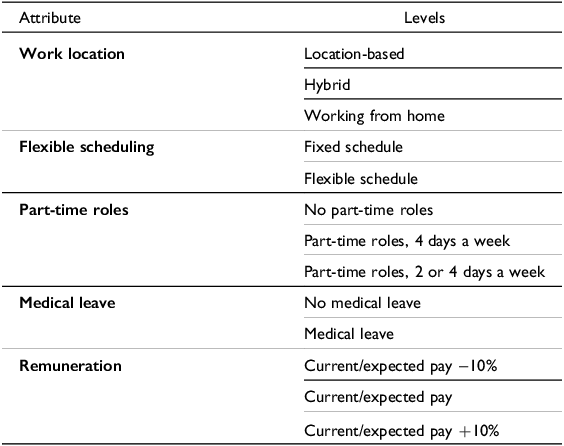
Experimental design
Each participant completed the same 12 choice scenarios. Each choice scenario required participants to state their preference between two (fictional) jobs, which varied according to the five attributes described above. Participants were also able to select a ‘prefer neither’ option (Campbell and Erdem Reference Campbell and Erdem2019).
The choice scenarios were generated using ChoiceMetrics/Ngene using a d-error minimisation approach. A d-error minimisation approach is a commonly used approach for designing choice experiments that involves minimising the determinant of the information matrix of the experimental design (Soekhai et al Reference Soekhai, de Bekker-Grob, Ellis and Vass2019; Walker et al Reference Walker, Wang, Thorhauge and Ben-Akiva2018). This ensures that the resulting experimental design is efficient, optimal, and balanced. See Appendix 1 for more details on the priors used to finalise the final survey design.
It is possible that particular choice scenarios, or attributes, might become overly salient due to the order in which the choice scenarios are presented or position of the attributes on the screen. To minimise order effects arising within the choice scenarios, we randomised the 12 choice scenarios between participants. Additionally, to minimise order effects between the attributes, we randomised the order in which the attributes were presented between participants, with the exception of remuneration, which was always the final attribute presented in order to reflect the style of a typical job advert. For the remaining four attributes, a quarter of participants saw choice scenarios that presented work location as the first attribute, a quarter saw flexible scheduling as the first attribute and so on.
Procedure
The study was completed online. Participants first completed a questionnaire, which collected demographic information including gender, as well as contextually relevant information concerning the participant’s disability status and their current/previous employment status. For disability status, we opted for a simple, self-reported measure of disability in line with what potential job candidates might fill in on an application form. The questionnaire also included questions related to the participant’s current/most recent job. The questions included whether the participant could set their own hours, had flexible or fixed shift patterns, worked part-time, and whether they had access to discretionary medical leave.
Participants then began the DCE. Participants were first presented with instructions describing the DCE procedure and the attributes used. The instructions are included in an appendix. Participants were shown two fictional jobs, Job A and Job B, and asked to indicate which of the two jobs they preferred or if they preferred neither option. Figure 1 contains an example choice scenario.
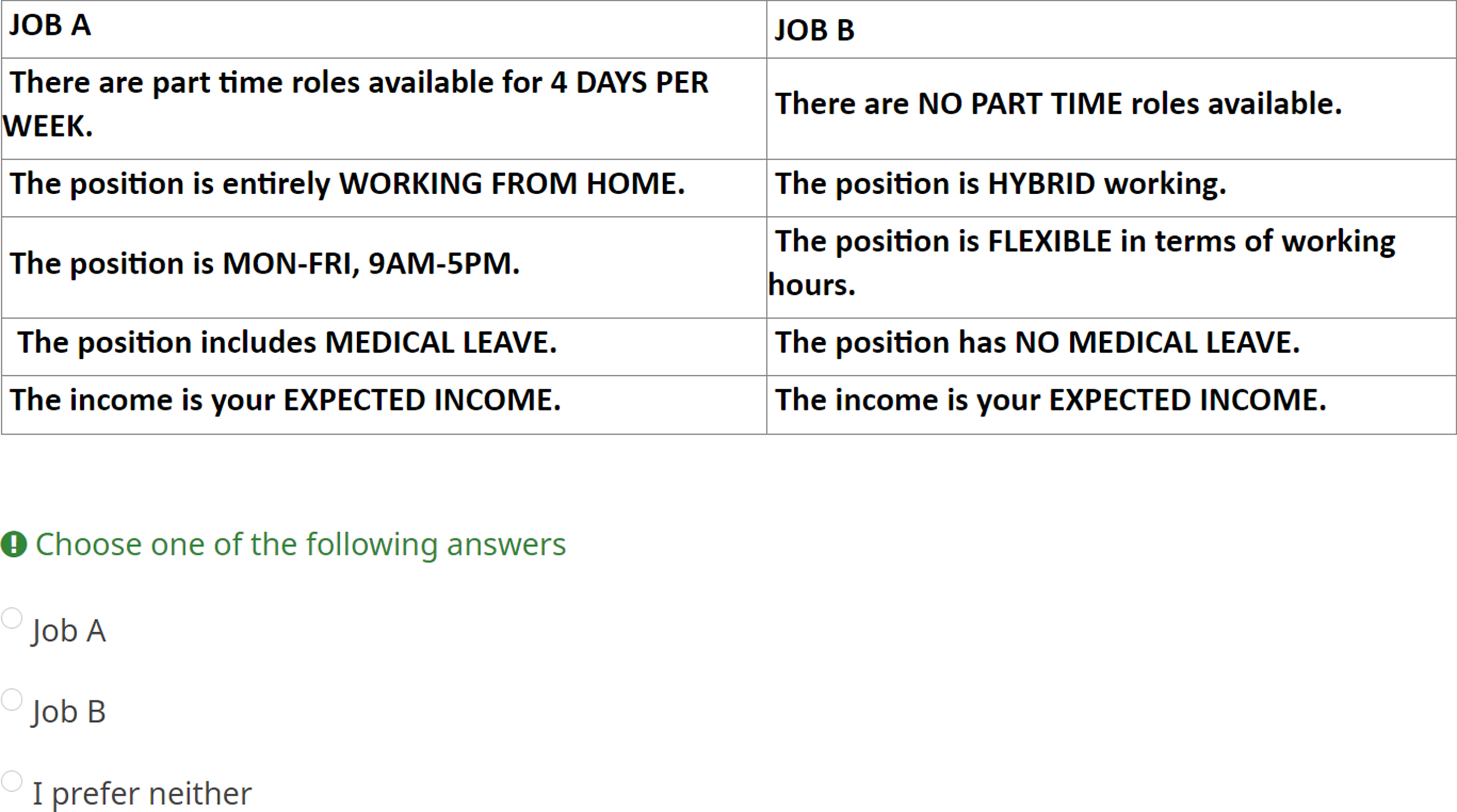
Figure 1. An example choice scenario.
Despite steps taken to ensure relevant attributes were chosen, participants may have been unwilling (or unable) to trade-off certain attribute levels, e.g. some people may only be able to work part-time and would not consider jobs with only full-time positions. This is termed a lexicographic preference. We investigated lexicographic preferences using a post-DCE survey. Participants were asked about whether there were any attributes they could never consider for any reason.
Participants
The inclusion criterion for participation was that potential participants should be currently in employment or seeking employment. Further, we aimed to recruit an approximately equal number of people with and without disabilities to analyse how the job preferences of people with disabilities compared to people without disabilities. We employed a convenience sampling strategy. Participants were recruited through two distinct channels. Participants were initially recruited through the local Cornish business community, including the Federation of Small Businesses and the Chamber of Commerce via in-person events such as business breakfasts or other business networking events. The online survey platform Prolific was used to recruit a further 200 participants from across England (UK). Participants recruited through Prolific received compensation in line with the standard Prolific remuneration policy – payments were made following Prolific’s Fair Rewards policy which specifies participants must be paid at a minimum rate of £9 per hour. Ethical approval for this research was granted by University of Exeter Business School (reference: eUEBS003338). Participants were informed that they would be taking part in a job choice study. There is debate within the literature about the use of Prolific and other online survey platforms for recruitment. Since we are interested in people’s preferences for flexible working, people who choose to complete surveys on Prolific may represent a biased sample which may be a limitation of our methodology (see limitations for further discussion on this point).
Hypotheses
We now present a series of testable hypotheses related to the experimental design outlined above. We begin with a general hypothesis that people with disabilities have different preferences with respect to job choice compared to people without disabilities before moving to specific hypotheses relating to the attributes within our DCE.
Hypothesis 1: People with disabilities and people without disabilities have different job choice preferences.
Hypothesis 2: People with disabilities have stronger preferences for jobs with medical leave than people without disabilities.
Hypothesis 3: People with disabilities have stronger preferences for jobs with flexible working hours than people without disabilities.
Hypothesis 4: People with disabilities have stronger preferences for jobs with hybrid working than people without disabilities.
Hypothesis 5: People with disabilities have stronger preferences for jobs offering working from home than people without disabilities.
Hypothesis 6: People with disabilities have stronger preferences for jobs that offer part-time positions (4 days a week) than people without disabilities.
Hypothesis 7: People with disabilities have stronger preferences for jobs that offer part-time positions (2 or 4 days a week) than people without disabilities.
Data analysis
Initial analysis was undertaken using multinomial logit regression with attribute levels included as an independent variable and disability interactions to examine differences in preferences between people with disabilities and people without disabilities. In order to investigate potential heterogeneity of preferences across the sample, we also performed a latent class analysis. This analysis allowed us to characterise subgroups of participants (latent classes) with homogeneous preferences based on observed personal characteristics (Yoo Reference Yoo2020). The personal characteristics included in this analysis were gender, disability status, and age. Goodness of fit was the primary method of determining the optimal number of classes measured using the consistent Akaike information criterion (CAIC) and Bayesian information criterion (BIC) (Spurk et al Reference Spurk, Hirschi, Wang, Valero and Kauffeld2020; Weller et al Reference Weller, Bowen and Faubert2020). A secondary consideration was the interpretability of the latent classes after discussion with the research team. We report the log odds from both the multinomial logistic regression and latent class analysis. We also report the average marginal effects. From these regressions, willingness-to-pay (WTP) was derived for each attribute level, except for remuneration which is used to calculate WTP. This estimates the proportion of their total salary a participant would be willing to forgo for a particular attribute level compared to a baseline level, e.g. what proportion of salary a participant would be willing to ‘give up’ in order to work from home. WTP is therefore expressed in terms of the proportions of their current salary. Baseline attribute levels were those closest to pre-COVID working patterns, i.e. no medical leave, fixed schedules, location-based work, and no part-time job availability. Proportions of salary are used in order to reduce potential income effects, since higher-income participants are likely willing to forgo more in absolute monetary terms compared to lower-income participants.
Results
Descriptive statistics
A total of 253 participants completed the DCE procedure. Table 2 presents descriptive statistics relating to our sample. It should be noted that these questions were optional, and some participants chose not to answer certain questions. Three-quarters (75%) of participants were female and a majority (86%) were white. More women with disabilities were employed in January to March 2023 than men with disabilities (Powell Reference Powell2023), which partly accounts for this figure. The average age was 39 years old. The most commonly reported impairments were physical impairments (35%), long-term chronic pain (33%), and mental health conditions (29%) (note that participants could indicate multiple impairments). Over 40% of participants were in full-time employment or self-employment and around a quarter of participants were in part-time employment or self-employment. Over 75% of employed participants reported working from home at least some of the time. However, less than 30% of employed participants indicated that they had worked from home prior to COVID-19. Access to discretionary medical leave was reported by 55% of employed participants. Just over half of employed participants indicated that they had the option of flexible scheduling.
Table 2. Descriptive statistics
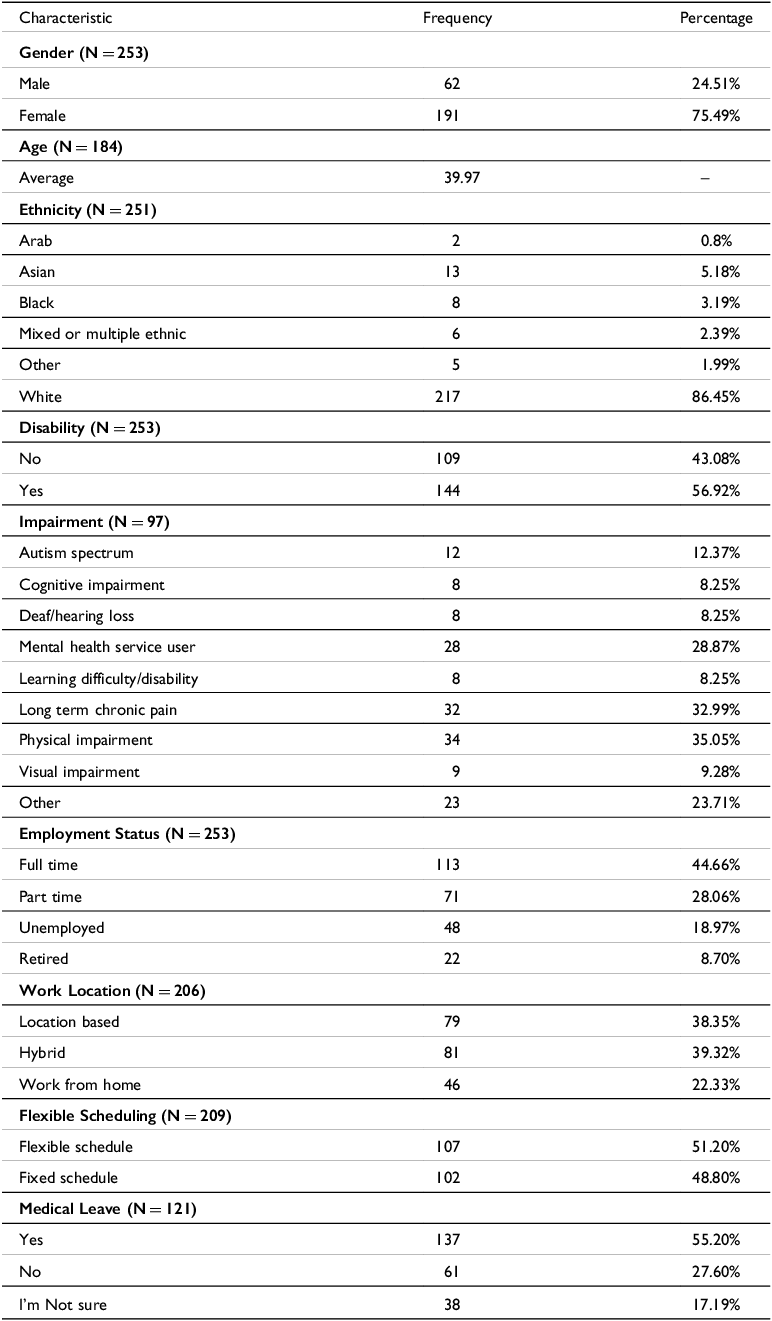
Note. For Impairment percentages are as a percentage of disabled participants who answered the question about their specific impairment(s) (N = 97). Participants could report multiple impairments.
Multinomial logistic regression
The results of the multinomial logistic regressions are reported in Table 3. Several of the disability interactions are significant, suggesting that there are statistically significant differences in the job preferences of people with disabilities compared to people without disabilities. In particular, these results suggest that people with disabilities have significantly different preferences for flexible scheduling, hybrid working, and part-time jobs (2 or 4 days a week). We perform a Wald omnibus test that all of the disability interaction terms are jointly equal to zero, which is rejected (p < 0.001), leading to our first result.
Table 3. Pooled multinomial logistic regression with disability interactions
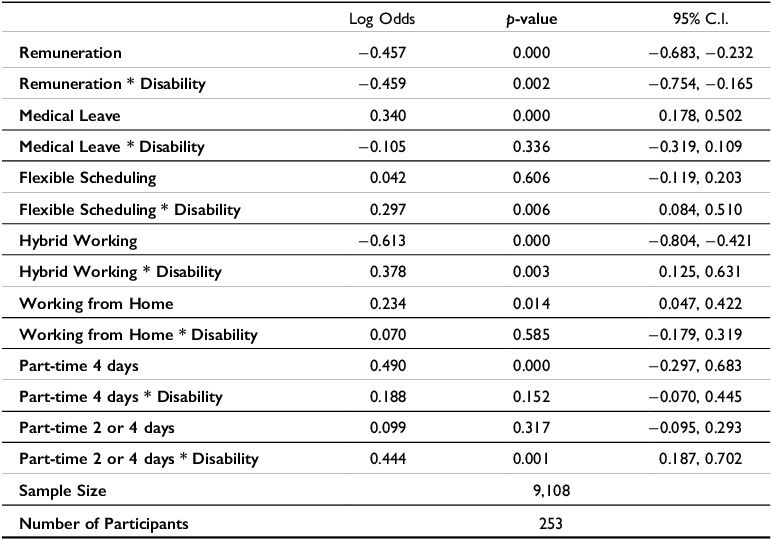
Note. This table reports the log odds for each attribute level obtained from a pooled multinomial logistic regression with disability interactions. The table also reports the associated p-value and 95% confidence intervals (C.I.). Reference categories are no medical leave, fixed scheduling, location-based work and no part-time jobs available. The model also included alternative specific constants for Job Option B and for the Optout, which Job Option A as the reference category.
Result 1: Overall job preferences are significantly different between people with disabilities and people without disabilities (p < 0.001).
-
2.1. Latent Class Analysis
All 184 participants who completed the optional questions relating to their gender, disability status, and age were included in the latent class analysis (i.e. 72.7% of the sample 184/253).
We determined the optimal number of classes using a combination of goodness-of-fit measures and the interpretability of the resulting latent classes. We began by calculating two goodness-of-fit criteria(CAIC and BIC) for models with two to seven classes. Models featuring either three (according to the CAIC) or five (according to the BIC) classes performed best. We opted for a model with three as estimating a smaller number of classes within a given size of data set tends to result in better goodness-of-fit (Chen et al Reference Chen, Li, Liu and Ying2016) and the model with three classes also offered a clearer and easier interpretation of the resulting latent classes.
The results of the latent class analysis with three classes can be seen in Table 4. The proportion of women in Class 1 and Class 3 was significantly higher compared to Class 2 (p < 0.001). Further, Class 2 had a lower proportion of people with disabilities (p < 0.001) and a lower average age (p < 0.001) compared to Classes 1 and 3. Members of Class 2 were therefore more likely to be younger, male, people without disabilities than Classes 1 and 3. The only significant demographic difference between Class 1 and 3 is that Class 3 has a higher average age (p < 0.001). There are, however, some stark differences in coefficients between Classes 1 and 3, especially for the location and part-time attributes. Notably for Class 2, the remuneration coefficient is not significant, suggesting it does not impact choices.
-
2.2. Willingness-to-Pay Estimates
Table 4. Latent class analysis
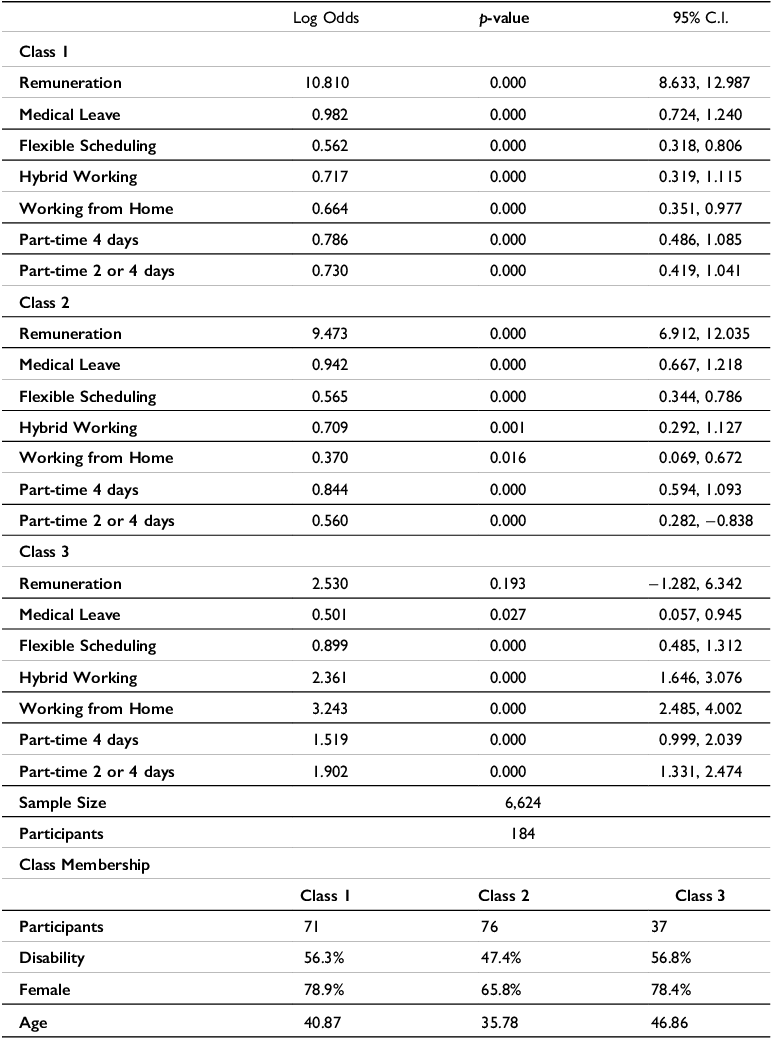
Note. This table reports the log odds for each attribute level obtained from a latent class analysis logistic regression. The table also reports the associated p-value and 95% confidence intervals (C.I.). Reference categories are no medical leave, fixed scheduling, location-based work and no part-time jobs available. The model also included alternative specific constants for Job Option B and for the Optout, which Job Option A as the reference category.
From the multinomial logistic regressions, we derived average WTP estimates for each attribute-level from the average marginal effects, which are reported in Table 5. Whilst we refer to these estimates as WTP, it should be noted that the interpretation is slightly different to typical DCE WTP estimates since they represent the proportion of income that participants would be willing to give up in order to have access to the given attribute-level.
Table 5. Average marginal effects and average willingness-to-pay from multinomial logistic regression presented in Table 3

Note. This table reports the average marginal effect (AME) from the multinomial logistic regression reported in Table 3. The table also reports the associated p-value and 95% confidence intervals (C.I.). Reference categories are no medical leave, fixed scheduling, location-based work and no part-time jobs available.
In terms of the average marginal effects from the multinomial logistic regression, we tested for differences between the average marginal effect for people with disabilities and people without disabilities. The average marginal effects were significantly different for the flexible scheduling, hybrid working and part-time (2 or 4 days per week) attribute-levels. The average marginal effects for medical leave, working from home and part-time (4 days per week) are not significantly different. We now state results relating to our remaining hypotheses.
Result 2: Preferences for medical leave are not significantly different between people with disabilities and people without disabilities (p = 0.333).
Result 3: People with disabilities have significantly stronger preferences for flexible scheduling compared to people without disabilities (p = 0.006).
Result 4: People without disabilities have significantly stronger preferences for hybrid working compared to people with disabilities (p = 0.003).
Result 5: Preferences for working from home are not significantly different between people with disabilities and people without disabilities (p = 0.583).
Result 6: Preferences for part-time jobs (4 day per week) are not significantly different people with disabilities and people without disabilities (p = 0.144).
Result 7: People with disabilities have significantly stronger preferences for part-time jobs (2 or 4 days per week) compared to people without disabilities (p = 0.001).
Similarly, for the latent class analysis, we derived WTP estimates for each attribute-level and for each class, which are reported in Table 6. When considering the latent class analysis, we compared the WTP estimates for each attribute-level between classes, which can be seen in Table 6. As with the latent class analysis, there are some stark differences between Class 1 and Class 3, with Class 3 having higher WTP estimates for every attribute-level – although none of these WTP estimates are significant, possibly due to the small sample size for Class 3. We also note that Classes 1 and 2 have fairly similar WTP estimates for all attribute-levels, although Class 2 placed greater importance on hybrid working and part-time jobs of four days per week compared to Class 1 who placed greater importance on working from home and on the availability of part-time roles.
-
2.3. Lexicographic Preferences
Table 6. Willingness-to-pay from latent class analysis presented in Table 4
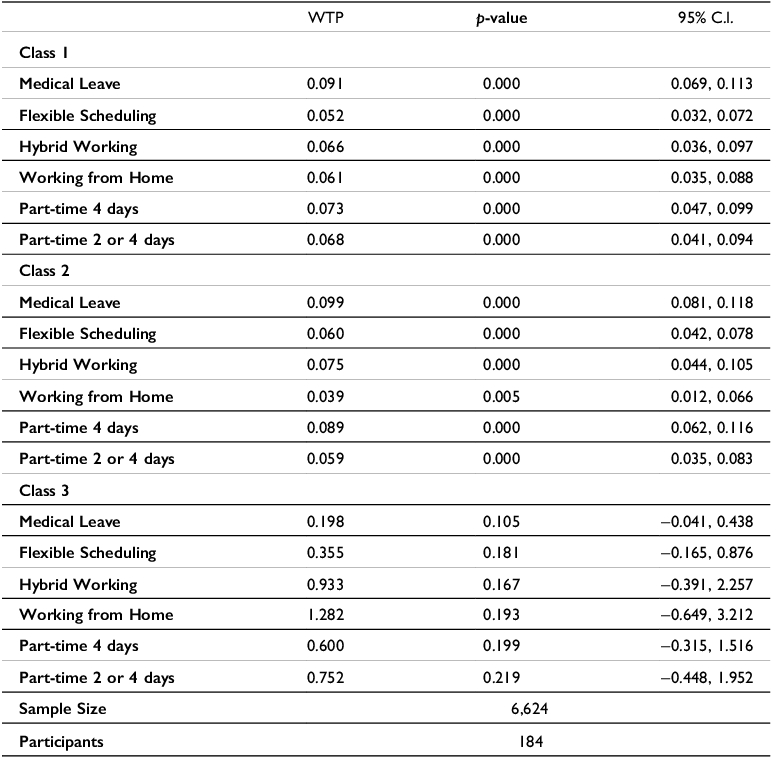
Note. This table reports the log odds for each attribute level obtained from a pooled multinomial logistic regression with disability interactions. The table also reports the associated p-value and 95% confidence intervals (C.I.). Reference categories are no medical leave, fixed scheduling, location-based work and no part-time jobs available.
Table 7 presents, for each class, the proportion of participants who indicated that they could never consider a given attribute-level e.g. the proportion of participants who could never choose a full-time job and so would never choose jobs with no part-time roles. For Class 1 and Class 2, the highest rates of attributes that would never be considered were for jobs that either had no medical leave or no part-time roles available, with 22.5% and 21.1% of participants in Class 1 (11.8% and 25.0% in Class 2) indicating that they could never choose a job that had these attribute-levels. For Class 3, 35% of participants indicated that they would not consider jobs with no part-time roles, though location-based jobs had the second highest rate of never being considered (27.0% indicated they would not consider location-based jobs). In both cases this is significantly (p < 0.001) higher than Classes 1 and 2.
Table 7. Proportion who consider could never consider an attribute-level for each class
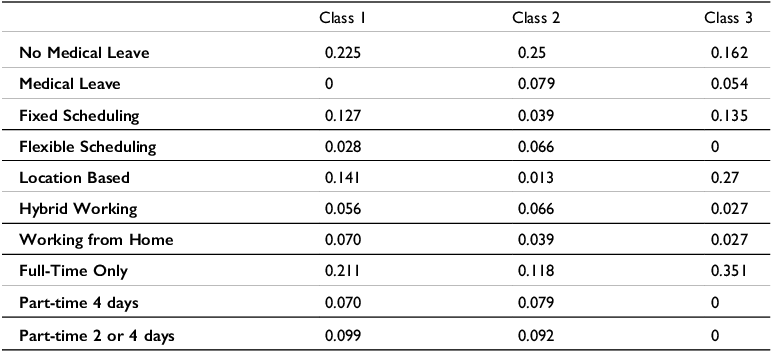
Discussion
The study reports results of a Discrete Choice Experiment that investigated the job preferences of people with, and people without, disabilities for a series of relevant attributes. The attributes related to the availability of discretionary medical leave, of flexible scheduling opportunities, the possibility to work from home (at least some of the time) and whether there are part-time jobs available or not. We found that people with disabilities had significantly stronger preferences for flexible scheduling and the availability of part-time jobs compared to people without disabilities. Conversely, people without disabilities had significantly stronger preferences for hybrid working compared to people with disabilities. A high proportion of the sample were women, partly due to high numbers of women with disabilities within work and our sampling criteria which targeted people with disabilities. However, we do control for gender in our statistical analysis. Other studies have shown that the employment experiences of working women with disabilities are shaped by dual disadvantages associated with disability and gender (Brown and Moloney Reference Brown and Moloney2019), so our study is likely to reflective of both these experiences. The importance of intersectionalities between gender, disability and the ability to work from home has been raised by (Klinksiek et al Reference Klinksiek, Jammaers and Taskin2023) as a future research area but has received relatively limited attention within the literature.
There also needs to be an acknowledgement of the role of job matching processes to align the preferences of people with (and without) disabilities to the needs of employers and the practicalities of the workplace where applicable (e.g. where location-based work is essential). This mismatch is also raised by Klinksiek et al (Reference Klinksiek, Jammaers and Taskin2023) when they argue that these initiatives could set up a notion of an ‘ideal worker’ “where work is performed anywhere and anytime” that is “a mismatch between the perceptions of what constitutes an ideal worker and the actual worker” which “leads to lower performance evaluations from managers as well as career penalties.” To counter this potential mismatch, they emphasise the importance of contingent factors that can moderate the potential challenges. These contingent factors include an inclusive organisation ethos committed to reduce bias in employment strategies and an inclusion in workspace for both employees with and without disabilities to enable shared social participation. Ultimately this would also rely on improving attitudes among employers to overcome the persistent fears and myths about productivity, costly adjustments and sickness absence (Bonaccio et al Reference Bonaccio, Connelly, Gellatly, Jetha and Martin Ginis2020).
The results of our latent class analysis suggest that Class 3 primarily consisted of participants who would most benefit from flexible work conditions and are most work-limited by conventional pre-COVID work conditions. People with disabilities are not less likely to want to work than people with disabilities (Ali et al Reference Ali, Schur and Blanck2011) but may be less able to work under particular conditions. Table 7 seemed to corroborate that Class 3 included participants more constrained by pre-COVID working conditions because 27% of Class 3 indicated that they could never consider location-based work, while 35% could never consider full-time work. This was significantly more than the other two classes. It therefore appears that Class 3 contains people with disabilities who are most constrained by pre-COVID working conditions, limiting their ability to accept certain jobs. Class 3 are particularly likely to reap the benefits of teleworking opportunities since 27% of them are unable to accept location-based work. As such, our results suggest that it may be older women with disabilities who would benefit most from more flexible job designs, in line with existing research (Pagán Reference Pagán2012). We also anticipate that the ability to work from home and the availability of part-time jobs are likely to be attractive to other groups of society that were constrained by pre-COVID working practices, including parents of young children and people with caring responsibilities. For example, research suggests increased flexibility in the workplace may reduce gender inequalities (Chung et al Reference Chung, Birkett, Forbes and Seo2021). Future research may wish to consider how changes to working conditions post-COVID have affected other groups of people who were disproportionately excluded by pre-COVID working conditions, (Klinksiek et al Reference Klinksiek, Jammaers and Taskin2023). Greater opportunities for working from home have been identified as a possible benefit for people with disabilities of the pandemic COVID (Schur et al Reference Schur, Ameri and Kruse2020). However, employers must ensure that they continue to provide appropriate support for home workers as they would for location based staff to avoid the potential for negative health effects derived from working from working (Oakman et al Reference Oakman, Kinsman, Stuckey, Graham and Weale2020).
Limitations
People with disabilities can have a broad variety of impairments. Unfortunately, our relatively small sample does not allow us to present sub-group analyses between different impairments. For example, it may be the case that people with physical impairments value the ability to work from home more than people with mental impairments who may be more focused on the social value of work (i.e. the opportunities for socialising that working from a physical work location involves). As such, future studies may wish to investigate differences in preferences and WTP according to the nature of impairment.
The generalisability of our results is likely to be limited by the fact that we relied on a convenience sampling method and results may not be applicable beyond the sample we analysed. Further, our relatively small sample size prevented us from also including interaction terms in our multinomial regression or latent class analysis. However, there may be important interactions that contribute towards participants decision making processes, for example the interaction between the availability of part-time roles and flexible scheduling may be important for participants who are only able/want to work limited hours on evenings or weekends. Conversely, the availability of medical leave may not be seen as important when flexible scheduling is available. Future qualitative studies could to inform the likelihood and type of interaction terms before undertaking further quantitative research.
Further, there may be differences in preferences between people who complete surveys on Prolific (i.e. our participants) and the general public. For example, people completing surveys on Prolific may have greater preferences for flexible scheduling compared to people and we may therefore overestimate the extent to which people prefer flexible scheduling. This would represent sampling on our dependent variable. Nonetheless, we do find significant differences between disabled and non-disabled people. Completing surveys on Prolific could also be seen as a form of precarious work in itself (Joseph-Goteiner Reference Joseph-Goteiner2024), especially when people are dependent on Prolific to supplement their income from other sources. While approximately two thirds of our sample were in employment, they could therefore be using Prolific to contribute to their income. Future research could alleviate these concerns with a more robust recruitment strategy.
Conclusion
We present evidence on the relative job preferences of people with disabilities compared to people without disabilities. Our results suggest that people with disabilities value the ability to work from home and that an increased prevalence of teleworking opportunities could lead to a labour market that is more inclusive for people with disabilities. The increased availability of teleworking as a result of the COVID-19 should be capitalised on to create a ‘new normal’ that works for people with disabilities. Latent class analysis reveals that it may be young women with disabilities who are most likely to benefit from increased opportunities for home working and flexible scheduling. These results have the potential to inform effective methods for the recruitment and retention of people with disabilities and therefore may offer strategies that are able to contribute towards the narrowing of the disability employment gap.
Daniel W. Derbyshire is a Research Fellow at the University of Exeter in the Department for Public Health and Sports Science. He is a member of the Public Health Economics Group and his research focuses on disability employment and food policies.
Brit Grosskopf is a Professor at Economics at the University of Exeter. She is an experimental economist whose research focuses on social preferences, discrimination and the effect of emotions on decision making.
Theo Blackmore PhD is a Senior Research Fellow at Bath Spa University for the We Are The People project, which employs disabled people as Community Researchers to hear seldom heard voices.
Elizabeth Goodwin is a Research Fellow in Health Economics at the University of Exeter Medical School. Her research interests include preference elicitation methods, evaluation of complex health and social care interventions, and the health economics of multiple sclerosis.
Anne E. Spencer is a Professor in Health Economics and leads both applied and methodological health economics research, including economic evaluation alongside clinical trials, modelling of cost-effectiveness analyses, assessment and valuation of health outcomes, and econometric analysis of service reconfigurations and clinical guidelines using observational data sets.

